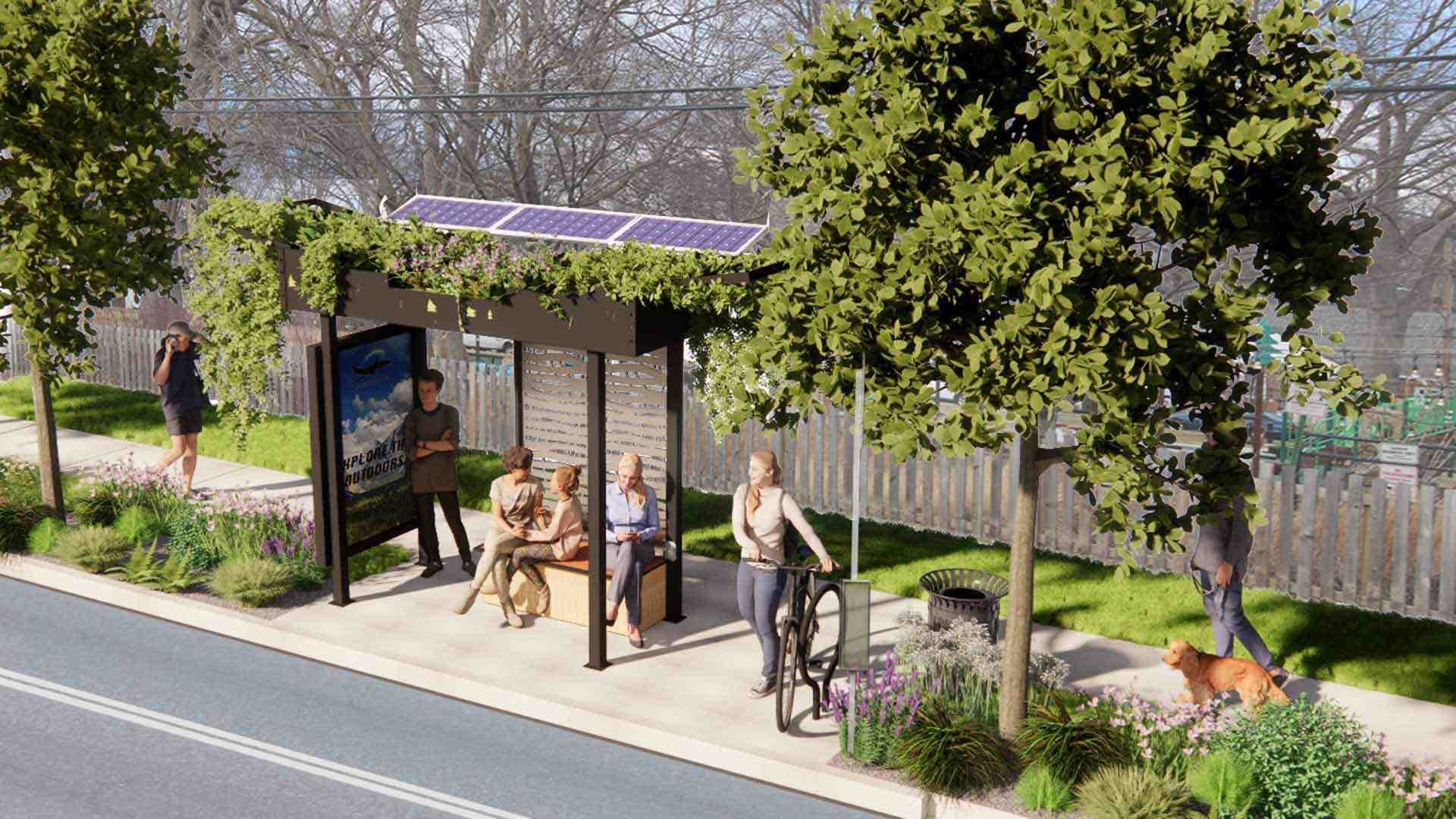Anyone who's waited for a bus on a scorching July day, dark winter evening or in a skin-soaking downpour knows the disappointment of finding an unsheltered bench—or worse, a lonely bus sign left open to the elements. In fact, less than one-fifth of bus stops in the U.S. offer any shelter for riders.
But an outgrowth of a University of Maryland-born business, Living Canopies, will soon help riders seeking shelter from the storm—or sun—by offering protective, energy-producing and beautiful transit oases. The inaugural batch of a new plant-packed eco-transit hub, called Cool Green Shelters, will be unveiled this summer in Hyattsville, just a few miles from UMD’s campus.
“We wanted to find a way to not just get people out of their cars, but bring value to communities,” said environmental science and technology Associate Professor David Tilley, CEO and co-founder of Living Canopies with former student Nick Cloyd ’13, M.S. ’17. “We see a lot of potential in the bus stop.”
Living Canopies’ route to transit stops began shortly after the company’s effort to bring its tendrilled, flowering patio umbrellas to the retail market temporarily folded; the company had just boxed up the last of an initial order for Sam’s Club in March 2020 when COVID-19 shut the world down. While Living Canopies stayed afloat during the pandemic and resumed a trial relationship with Sam’s Club in 2021, the events of the past year caused Tilley to re-examine the company’s mission.
“Our initial vision was to get people excited about ecosystem services and the symbiotic relationship we can have with nature,” he said. “I have teenagers at home, and after George Floyd, we were having a lot of conversations around social justice. I began to see the importance of supporting society rather just the environment.”
Tilley and Cloyd had included a shelter schematic in their initial patent application for Living Canopies, but had never pursued it; soon, Tilley began noticing uncovered bus stops everywhere, particularly on Baltimore Avenue—and who was waiting at the mostly barren patches of concrete. According to the Pew Research Center, Americans who are lower-income, Black or Hispanic, immigrants or under 50 are especially likely to use public transportation on a regular basis.
Tilley canvassed town and city officials along the corridor, who wrote letters of support and helped Tilley apply for grants; he secured the deal with Hyattsville in 2022, with construction of an initial 10 stops in early summer and the potential of more later.
“It’s an incredibly awesome idea and speaks to what Hyattsville really is,” said Lesley Riddle, director of public works for the city of Hyattsville. “We pride ourselves in supporting small businesses but also definitely need more bus shelters to promote the use of mass transit. This is a really innovative, sustainable way to do that.”
The Cool Green Shelter swaps the standard metal roof of a traditional transit stop for one overflowing with hardy native plants that harvest rain water into a reservoir below, provide evaporative cooling and reduce the urban heat island effect. Solar PVs make each shelter self-sufficient and power USB charging stations and LED lighting.
Bus shelters, said Tilley, are often owned and maintained by large advertising corporations, like ClearChannel, that select locations based on revenue data, often well-traveled streets in higher income areas. Cool Green Shelters not only make waiting for the bus more comfortable, they forge a different kind of sponsorship model based on an environmental social and governance framework.
“Not only can we make it more aesthetically better, we can create a new business model that allows towns to have them in more places,” he said.
While the shelters run around $30,000 each, Tilley hopes that grant opportunities and the promise of recurrent revenue from ad space can help ease the investment. Living Canopies is actively working with cities and towns across the state to roll out more stops in Maryland and is in talks with bus companies in other parts of the country. In the future, he hopes to outfit Cool Green Shelters with data-collecting technology to measure things like temperature, humidity and ozone, metrics that are gaining traction with the government and environmental research groups.
Tilley also sees the potential, untapped benefits a free-standing space—like a bus shelter—can offer. In the future, Cool Green Shelters could host urban agriculture, mini food pantries, lending libraries and public art.
“It’s not just a stop to get the bus, it has the potential to be a real neighborhood amenity,” he said.

